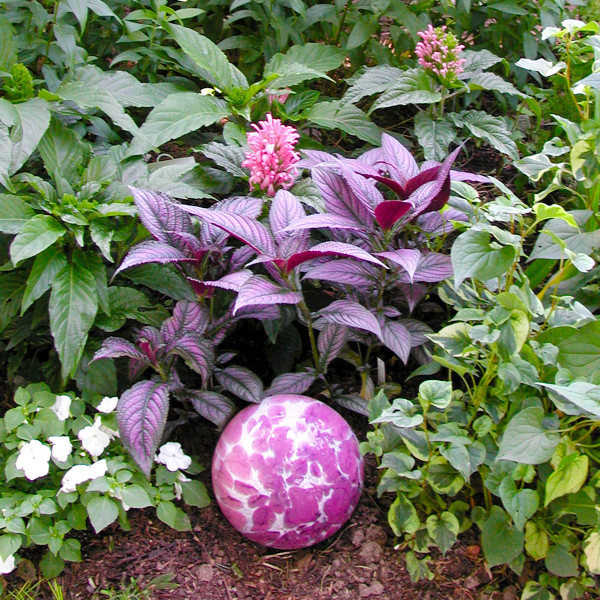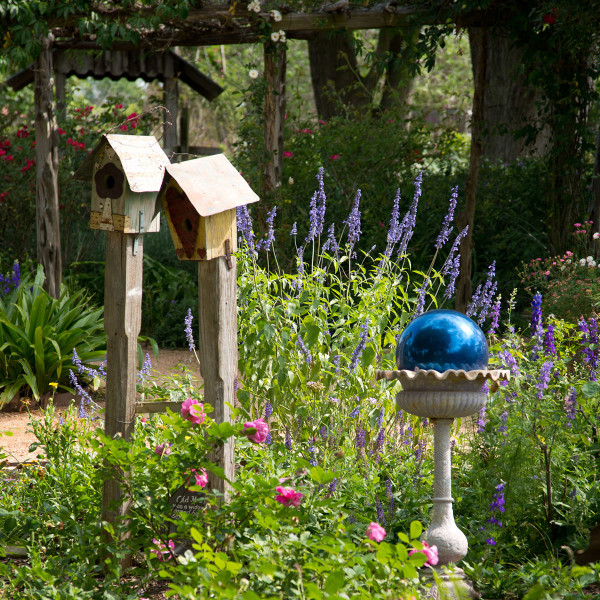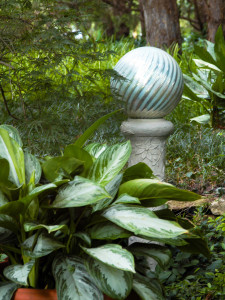WHEN WE STARTED OUR GARDEN CENTER years ago, I searched for gazing globes. I remembered them from my childhood in the Midwest and considered them attractive and funky garden art. My business partner deemed them tacky. This dichotomy continues today; you either like gazing globes or you find them totally ridiculous.

A pink mosaic globe carries out the color scheme as it nestles beneath purple Persian shield and pink Brazilian plume flowers. Photo © Mary Wilhite.
I remember a man who came to the nursery and upon noticing a gazing globe in our garden asked, “What is that for?” I explained that it was a garden ornament, but he still wanted to know its function. I had to admit that I only knew it as art, without getting into a philosophical discussion of the purpose of art in culture.
History
Now I could have explained to this man that garden balls have a long history. Starting in the 13th century, Italian glass blowers made decorative balls in various sizes and touted them as novel decorative ornaments for inside and outside. Many noblemen displayed these globes as symbols of wealth.

A shimmering pink and gold globe stops the eye in a planting of Brazilian rock roses. Photo © Mary Wilhite.
In the Victorian era, glass blowers learned to line the interior of the balls with mercury and solid colors, making them very reflective. These shiny balls enjoyed another period of popularity inside houses as well as in gardens. A large reflective ball would be placed on a side table or pedestal just inside the dining room door so servants could stand outside the room and still see the guests to know when they needed service. These globes were known as butler balls.
Folklore
Many stories grew up around gazing globes, one of which claimed that a globe placed next to the front door would protect the house from evil spirits and witches. A witch would see her reflection in the shiny sphere and be frightened away. These spheres were known as witch balls. On the lighter side of this tale was the belief that the pretty globes attracted fairies to the garden, gaining the spheres the name fairy balls.

In this smile-worthy garden setting a shiny blue globe is perched in a birdbath beside rustic birdhouses. Photo © Neil Sperry, Antique Rose Emporium.
Modern uses
Brightly colored, reflective gazing globes enjoyed a modern revival in the mid-20th century, again as symbols of wealth and prosperity. More recently, art glass and mouth-blown globes have gained popularity as decorative garden objects. Flat-bottomed globes can be displayed on tables or placed on top of the ground amid short flowers or foliage plants in a flowerbed. Mouth-blown globes have a stem on them so need to be placed on a pedestal or in a pot with a diameter slightly smaller than that of the globe itself.
Choose globes in complementary colors to the flowers in the bed for a soothing look. For more punch, add a ball in a contrasting hue to the surrounding flora. Nestle the sphere in the landscape so it looks like it is growing along with the plants.
Care of your globe

A favorite Sperry shade garden accessory, this striking globe has a stand of equal importance. Photo © Neil Sperry.
Although most gazing globes are made of glass, the glass is usually very thick and not fragile. I have owned a globe for over 20 years and leave it outside all year ‘round with no problems. If you live in an area with freezing temperatures in the winter, you may want to bring your globe inside for the winter, especially if it has a mosaic finish on the outside. For a globe with a silvered interior, keep the stem completely covered to prevent moisture from collecting inside the ball and damaging the finish.

